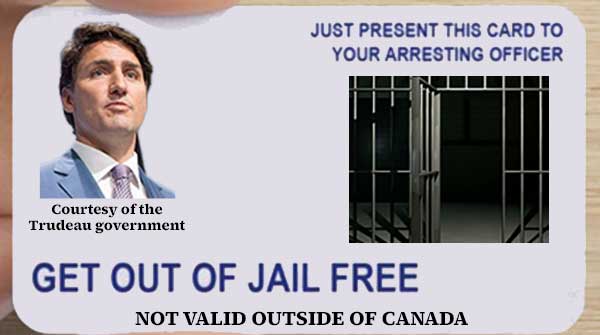How can a racially based system even be called “justice”?
 Provincial justice ministers in Manitoba and Saskatchewan are urgently calling on the federal government to “convene a bail reform summit to address the increasing level of violence faced by Canadians.” Other provincial justice ministers have voiced similar concerns.
Provincial justice ministers in Manitoba and Saskatchewan are urgently calling on the federal government to “convene a bail reform summit to address the increasing level of violence faced by Canadians.” Other provincial justice ministers have voiced similar concerns.
What is going on?
The immediate concern is bail reform. But bail reform is part of an ongoing racially based strategy of the Supreme Court and federal government attempting to reduce the high rate of incarceration of indigenous offenders (and now, black offenders) by the simplistic and wrong-headed method of releasing indigenous accused with records of violence where others would not be released, sentencing indigenous offenders to shorter jail terms than others would receive, and paroling dangerous offenders – or simply not using jail terms at all for violent offences.
 |
| Related Stories |
| Too many Indigenous men abuse too many Indigenous women
|
| Race-based police data won’t end systemic issues
|
| One Indigenous inquiry after another proves fruitless
|
There are many recent examples of indigenous offenders – who definitely should have been in jail – committing violent offences. The most egregious recent example is that of Myles Sanderson, who stabbed 11 people to death and injured many more. Sanderson had a terrible record and would almost certainly have been in jail if he had not been indigenous. As it is, his victims were indigenous. How a federal government strategy that results in the murder of indigenous people can be said to be helping indigenous people is hard to fathom.
The case is not unique. The vast majority of the victims of violent indigenous men and women are indigenous.
The Sanderson case is one of many, such as the recent murder of a police officer by an indigenous man who should not have been on the street. These are only two of the many cases that alarm the provincial justice ministers.
The racially based release and sentencing strategy is fundamentally flawed. The notion that “systemic racism” is responsible for so many indigenous and black offenders ending up in the justice system is simply incorrect. The fact is a disproportionate number of indigenous and black men commit crimes, and that’s why so many are in jail. It is not “systemic racism” or “poverty” that is responsible for their offending. The fact that the great majority of indigenous and black people do not commit crimes – including low-income people – is proof of the falsity of the “systemic racism” and “poverty” theories.
To illustrate the weakness of the reasoning, consider that there are far more men than women in prison. Does this disproportion mean there is something wrong with the system, so the numbers should be evened out by letting more men out of prison or putting more women in?
In the case of ethnic groups that are underrepresented in the prison population, should we be putting more in jail? There are practically no Chinese Canadians in our jails. Would it make sense to adopt policies that would incarcerate more Chinese Canadians to even out the numbers? That “solution” seems to align with the flawed reasoning on this topic.
These “solutions” are obviously absurd, but that is what racially based justice attempts to do.
It all goes back to the Gladue case. A well-intentioned Supreme Court set out to solve the problem of indigenous overrepresentation in Canada’s jails by imposing a racially based system of selective sentencing. The court just made up a complicated sentencing formula that applied only to indigenous offenders. In basic terms, indigenous offenders would receive lighter sentences than non-indigenous offenders. Ottawa picked up on this and amended the Criminal Code accordingly.
But the fact that the indigenous incarceration rate has continued to rise despite these racial sentencing schemes is clear proof that the strategies don’t work: they just make for more crime victims – who are overwhelmingly indigenous.
Just think of the message sent to an indigenous victim of a serious assault who watches her abuser escape jail, where a non-indigenous offender would receive a jail term. The message the system sends to her is clear – she is not worth as much as a non-indigenous victim. Or think of the families of Myles Sanderson’s murder victims. Were they helped by the release of a monster who was only allowed to kill because he was indigenous?
Even though racially based sentencing has been an abject failure, it is being accelerated. Indigenous offenders, like Myles Sanderson, are now released on bail or parole, despite violent records, in circumstances where a non-indigenous offender would stay safely in jail. And those truly dangerous people are victimizing law-abiding Canadians – most of whom are indigenous.
How is that helping indigenous people? How is that fair to anyone? And how can a racially based system even be called “justice”?
“Justice” is one set of laws for everyone.
Brian Giesbrecht, a retired judge, is a Senior Fellow at the Frontier Centre for Public Policy.
For interview requests, click here.
The opinions expressed by our columnists and contributors are theirs alone and do not inherently or expressly reflect the views of our publication.
© Troy Media
Troy Media is an editorial content provider to media outlets and its own hosted community news outlets across Canada.

